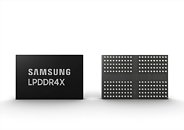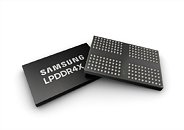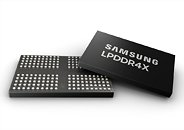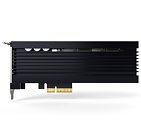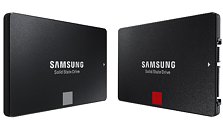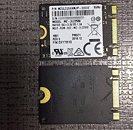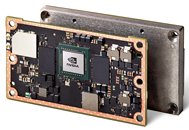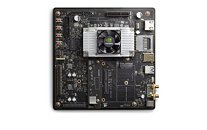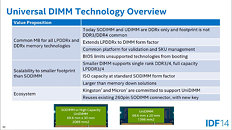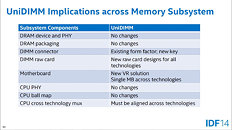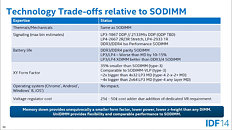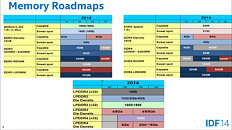Apr 18th, 2025 13:33 EDT
change timezone
Latest GPU Drivers
New Forum Posts
- RX 9000 series GPU Owners Club (388)
- Guess my potato specs (18)
- GPU Pricing and Performance (13)
- NVFlash for RTX 50 Series (Blackwell) (1)
- GPU Memory Temprature is always high (18)
- Looking for 4060 MXM-A VBIOS (6)
- SK hynix A-Die (Overclocking thread) only for RYZEN AM5 users (65)
- DTS DCH Driver for Realtek HDA [DTS:X APO4 + DTS Interactive] (2146)
- What's your latest tech purchase? (23571)
- Drives fail to work with Rufus Windows TO GO (1)
Popular Reviews
- ASUS GeForce RTX 5060 Ti TUF OC 16 GB Review
- NVIDIA GeForce RTX 5060 Ti PCI-Express x8 Scaling
- Palit GeForce RTX 5060 Ti Infinity 3 16 GB Review
- G.SKILL Trident Z5 NEO RGB DDR5-6000 32 GB CL26 Review - AMD EXPO
- ASUS GeForce RTX 5060 Ti Prime OC 16 GB Review
- Zotac GeForce RTX 5060 Ti AMP 16 GB Review
- MSI GeForce RTX 5060 Ti Gaming OC 16 GB Review
- Teevolution Terra Pro Review
- MSI GeForce RTX 5060 Ti Gaming Trio OC 16 GB Review
- ASUS GeForce RTX 5080 TUF OC Review
Controversial News Posts
- NVIDIA GeForce RTX 5060 Ti 16 GB SKU Likely Launching at $499, According to Supply Chain Leak (182)
- NVIDIA Sends MSRP Numbers to Partners: GeForce RTX 5060 Ti 8 GB at $379, RTX 5060 Ti 16 GB at $429 (127)
- Nintendo Confirms That Switch 2 Joy-Cons Will Not Utilize Hall Effect Stick Technology (105)
- Over 200,000 Sold Radeon RX 9070 and RX 9070 XT GPUs? AMD Says No Number was Given (100)
- Nintendo Switch 2 Launches June 5 at $449.99 with New Hardware and Games (99)
- NVIDIA Launches GeForce RTX 5060 Series, Beginning with RTX 5060 Ti This Week (98)
- Sony Increases the PS5 Pricing in EMEA and ANZ by Around 25 Percent (85)
- NVIDIA PhysX and Flow Made Fully Open-Source (77)
News Posts matching #LPDDR4
Return to Keyword Browsing
Samsung Begins Mass Production of 10 nm-class 16 Gb LPDDR4X DRAM for Automobiles
Samsung Electronics, the world leader in advanced memory technology, today announced that it has begun mass producing 10-nanometer (nm)-class 16-gigabit (Gb) LPDDR4X DRAM for automobiles. The latest LPDDR4X features high performance and energy efficiency while significantly raising the thermal endurance level for automotive applications that often need to operate in extreme environments. The 10nm-class DRAM will also enable the industry's fastest automotive DRAM-based LPDDR4X interface with the highest density.
"The 16Gb LPDDR4X DRAM is our most advanced automotive solution yet, offering global automakers outstanding reliability, endurance, speed, capacity and energy efficiency, ," said Sewon Chun, senior vice president of memory marketing at Samsung Electronics. "Samsung will continue to closely collaborate with manufacturers developing diverse automotive systems, in delivering premium memory solutions anywhere."
"The 16Gb LPDDR4X DRAM is our most advanced automotive solution yet, offering global automakers outstanding reliability, endurance, speed, capacity and energy efficiency, ," said Sewon Chun, senior vice president of memory marketing at Samsung Electronics. "Samsung will continue to closely collaborate with manufacturers developing diverse automotive systems, in delivering premium memory solutions anywhere."

Samsung Launches 800GB Z-SSD for HPC and AI Systems
Samsung Electronics, the world leader in advanced memory technology, today announced that it has launched an 800-gigabyte (GB) solid state storage drive-the SZ985 Z-SSD, for the most advanced enterprise applications including supercomputing for AI analysis. Developed in 2017, the new 800 GB Z-SSD provides the most efficient storage solution for high-speed cache data and log data processing, as well as other enterprise storage applications that are being designed to meet rapidly growing demand within the AI, big data and IoT markets.
"With our leading-edge 800 GB Z-SSD, we expect to contribute significantly to market introductions of next-generation supercomputing systems in the near future, enabling improved IT investment efficiency and exceptional performance," said Jinman Han, senior vice president, Memory Product Planning & Application Engineering at Samsung Electronics. "We will continue to develop next-generation Z-SSDs with higher density and greater product competitiveness, in order to lead the industry in accelerating growth of the premium SSD market."
"With our leading-edge 800 GB Z-SSD, we expect to contribute significantly to market introductions of next-generation supercomputing systems in the near future, enabling improved IT investment efficiency and exceptional performance," said Jinman Han, senior vice president, Memory Product Planning & Application Engineering at Samsung Electronics. "We will continue to develop next-generation Z-SSDs with higher density and greater product competitiveness, in order to lead the industry in accelerating growth of the premium SSD market."

Samsung Officially Launches SSD 860 PRO and 860 EVO Series
Samsung Electronics America, Inc. today introduced the 860 PRO and 860 EVO solid state drives (SSDs), the most up-to-date additions to the company's SATA interface lineup. The products are aimed at consumers who require fast, reliable performance across various applications, from everyday computing to heavy workloads and graphic-intensive operations. Building on the successful launch of the 850 PRO and 850 EVO - the industry's first consumer SSDs with V-NAND technology - the 860 PRO and 860 EVO achieve industry-leading performance for SATA SSDs, offering enhancements in speed, reliability, compatibility and capacity.
"The new 860 PRO and 860 EVO SSDs combine the latest 512Gb and 256Gb 64-layer V-NAND, up to 4GB LPDDR4 mobile DRAM and a new MJX controller to elevate the user experience for both consumers and businesses," said Un-Soo Kim, senior vice president of Brand Product Marketing, Memory Business at Samsung Electronics. "Samsung will continue to fuel meaningful innovations in the consumer SSD space and drive growth of the overall memory industry for years to come."
"The new 860 PRO and 860 EVO SSDs combine the latest 512Gb and 256Gb 64-layer V-NAND, up to 4GB LPDDR4 mobile DRAM and a new MJX controller to elevate the user experience for both consumers and businesses," said Un-Soo Kim, senior vice president of Brand Product Marketing, Memory Business at Samsung Electronics. "Samsung will continue to fuel meaningful innovations in the consumer SSD space and drive growth of the overall memory industry for years to come."

Samsung PM971 NVMe SSD Surfaces
Last week, we were introduced to Samsung's upcoming PM981 SSDs, which should give way to higher-performance parts such as the 980 series. Today, however, it's the slightly lower-tier PM971 platform that has surfaced, which should give way to Samsung 970 series of NVMe SSDs. Remember that the company seems to be moving away from their "EVO" and "PRO" monikers as performance differentiators, and this new nomenclature series should replace it come launch time.
The PM971-based SSDs will feature a 22mm x 16mm x 1.5mm multi-chip package that includes Samsung's Proton controller, LPDDR4 DRAM cache, and V-NAND flash into a single chip. As was to be expected from a more mainstream solution, performance will be noticeably lower (at least in pure numbers) when compared to the higher-tier 980 series.
The PM971-based SSDs will feature a 22mm x 16mm x 1.5mm multi-chip package that includes Samsung's Proton controller, LPDDR4 DRAM cache, and V-NAND flash into a single chip. As was to be expected from a more mainstream solution, performance will be noticeably lower (at least in pure numbers) when compared to the higher-tier 980 series.

Micron DRAM Production Facility Closed Due to Contamination
If you didn't already know, semiconductor production plants are some of the most aseptic locations you can usually find deployed around the world (remember those pictures of engineers wearing full-body suits and face masks?) As is often the case with cutting edge technology, there is usually no place for variable conditions; precision-level manufacturing requires the most stable, predictable working and manufacturing conditions that can possibly be achieved. When something goes wrong, say, when the nitrogen gas dispensing system of a major semiconductor manufacturing facility acts up and releases uncalibrated amounts of gas, things can go very wrong, very quickly.
That is exactly what happened with Micron's Fab 2 in Taiwan. Fab 2 was a result of Micron's Inotera acquisition, and production from this fab accounts for around 5.5% of the global DRAM supply (125,000 wafers per month) Due to the nitrogen gas dispenser malfunction, both wafers and equipment were contaminated, which Trendforce says reduced Inotera's production capability by 60,000 wafers. Now, granted, Micron has already officially come out and say that this was all a "minor accident" which "had no impact" on business. However, one has to consider that Fab 2 mainly specializes in production of LPDDR4 memory, which is essentially used in mobile phone environments - Apple being the company's biggest consumer of DRAM chips. With iPhone 8 production supposedly in full swing, if I were Micron, I would certainly prefer to take a bite out of my DRAM supplies than admit production capacity reduction and shortages to such a partner. If Apple were to take its business elsewhere, Micron would be hard-pressed to find another customer of that caliber.
That is exactly what happened with Micron's Fab 2 in Taiwan. Fab 2 was a result of Micron's Inotera acquisition, and production from this fab accounts for around 5.5% of the global DRAM supply (125,000 wafers per month) Due to the nitrogen gas dispenser malfunction, both wafers and equipment were contaminated, which Trendforce says reduced Inotera's production capability by 60,000 wafers. Now, granted, Micron has already officially come out and say that this was all a "minor accident" which "had no impact" on business. However, one has to consider that Fab 2 mainly specializes in production of LPDDR4 memory, which is essentially used in mobile phone environments - Apple being the company's biggest consumer of DRAM chips. With iPhone 8 production supposedly in full swing, if I were Micron, I would certainly prefer to take a bite out of my DRAM supplies than admit production capacity reduction and shortages to such a partner. If Apple were to take its business elsewhere, Micron would be hard-pressed to find another customer of that caliber.

NVIDIA Announces the Jetson TX2 IoT System
NVIDIA today unveiled the NVIDIA Jetson TX2, a credit card-sized platform that delivers AI computing at the edge -- opening the door to powerfully intelligent factory robots, commercial drones and smart cameras for AI cities. Jetson TX2 offers twice the performance of its predecessor, or it can run at more than twice the power efficiency, while drawing less than 7.5 watts of power. This allows Jetson TX2 to run larger, deeper neural networks on edge devices. The result: smarter devices with higher accuracy and faster response times for tasks like image classification, navigation and speech recognition.
"Jetson TX2 brings powerful AI capabilities at the edge, making possible a new class of intelligent machines," said Deepu Talla, vice president and general manager of the Tegra business at NVIDIA. "These devices will enable intelligent video analytics that keep our cities smarter and safer, new kinds of robots that optimize manufacturing, and new collaboration that makes long-distance work more efficient."
"Jetson TX2 brings powerful AI capabilities at the edge, making possible a new class of intelligent machines," said Deepu Talla, vice president and general manager of the Tegra business at NVIDIA. "These devices will enable intelligent video analytics that keep our cities smarter and safer, new kinds of robots that optimize manufacturing, and new collaboration that makes long-distance work more efficient."

Samsung Announces World's First 8GB LPDDR4 Memory Package
Samsung Electronics, announced today that it is introducing the industry's first 8-gigabyte (GB) LPDDR4 (low power, double data rate 4) mobile DRAM package, which is expected to greatly improve mobile user experiences, especially for those using Ultra HD, large-screen devices. The 8GB mobile DRAM package utilizes four of the newest 16 gigabit (Gb) LPDDR4 memory chips and advanced 10-nanometer (nm)-class process technology.
"The advent of our powerful 8GB mobile DRAM solution will enable more capable next-generation, flagship mobile devices around the world," said Joo Sun Choi, executive vice president of Memory Sales and Marketing at Samsung Electronics. "We will continue to provide advanced memory solutions offering the highest values and leading-edge benefits to meet the escalating needs of devices having dual camera, 4K UHD and VR features."
"The advent of our powerful 8GB mobile DRAM solution will enable more capable next-generation, flagship mobile devices around the world," said Joo Sun Choi, executive vice president of Memory Sales and Marketing at Samsung Electronics. "We will continue to provide advanced memory solutions offering the highest values and leading-edge benefits to meet the escalating needs of devices having dual camera, 4K UHD and VR features."

Micron Introduces Mobile 3D NAND Solution for Next-Generation Handhelds
Micron Technology, Inc., (Nasdaq:MU) today introduced the company's first 3D NAND memory technology optimized for mobile devices and its first products based on the Universal Flash Storage (UFS) 2.1 standard. Micron's initial mobile 3D NAND-based 32GB solution is targeted specifically for the high and mid-end smartphone segments which make up approximately 50 percent of worldwide smartphone volume[1]. As mobile devices bypass personal computers as consumers' primary computing device, user behaviors heavily impact the device's mobile memory and storage requirements. Micron's mobile 3D NAND addresses these concerns, enabling an unparalleled user experience that includes seamless high definition video streaming, higher bandwidth gameplay, faster boot up times, camera performance and file loading.
"Micron continues to advance NAND technology with our introduction of 3D NAND and UFS products for the mobile segment," said Mike Rayfield, vice president of Micron's mobile business unit. "The improved performance, higher capacity and enhanced reliability of 3D NAND will help our customers meet the ever-growing demand for mobile storage and will enable much more exciting end user experiences."
"Micron continues to advance NAND technology with our introduction of 3D NAND and UFS products for the mobile segment," said Mike Rayfield, vice president of Micron's mobile business unit. "The improved performance, higher capacity and enhanced reliability of 3D NAND will help our customers meet the ever-growing demand for mobile storage and will enable much more exciting end user experiences."

New Micron "Ultra" Memory Products Enable Next-Generation Automotive Systems
Micron Technology, Inc., today announced the availability of ultra reliable, ultra high-speed and ultra high-temperature parallel NOR Flash and low-power DDR4 (LPDDR4) DRAM to meet the increasing memory requirements for the automotive market segment. Micron's G18 NOR family offers the industry's highest-performance parallel NOR, while Micron's automotive-grade LPDDR4 solutions are an industry-first.
These new products meet the needs of automotive applications that require ultra high speed. The G18 family's high performance (266 MB/s)enables faster boot and code execution for higher-density applications, while LPDDR4 enables 33 percent higher peak bandwidth than DDR4. Additionally, Micron's new solutions deliver long-lasting reliability and meet ISO/TS certification requirements-with the G18 family enabling three times faster throughput over quad SPI NOR, and the LPDDR4 products undergoing additional package-level burn-in testing. Furthermore, Micron's G18 NOR products have options that meet the industrial temperature (IT) range of -40 to 85°C and the automotive-grade automotive temperature (AAT) range of -40 to 105°C. The LPDDR4 products have options that meet the automotive-grade industrial temperature (AIT) range of -40 to 95°C, as well as some future options that will meet the automotive-grade ultra temperature (AUT) range of -40C to 125°C, which is the highest operating temperature range in the industry, expected to be available in 2016.
These new products meet the needs of automotive applications that require ultra high speed. The G18 family's high performance (266 MB/s)enables faster boot and code execution for higher-density applications, while LPDDR4 enables 33 percent higher peak bandwidth than DDR4. Additionally, Micron's new solutions deliver long-lasting reliability and meet ISO/TS certification requirements-with the G18 family enabling three times faster throughput over quad SPI NOR, and the LPDDR4 products undergoing additional package-level burn-in testing. Furthermore, Micron's G18 NOR products have options that meet the industrial temperature (IT) range of -40 to 85°C and the automotive-grade automotive temperature (AAT) range of -40 to 105°C. The LPDDR4 products have options that meet the automotive-grade industrial temperature (AIT) range of -40 to 95°C, as well as some future options that will meet the automotive-grade ultra temperature (AUT) range of -40C to 125°C, which is the highest operating temperature range in the industry, expected to be available in 2016.

Samsung Starts Mass-producing First 8 Gigabit LPDDR4 Mobile DRAM
Samsung Electronics Co., Ltd., the world leader in advanced memory technology, announced today that it has started mass producing the industry's first 8 gigabit (Gb), low power double data rate 4 (LPDDR4) mobile DRAM based on the company's leading-edge 20-nanometer (nm) process technology. LPDDR memories are the most widely used "working memory" for mobile devices worldwide.
"By initiating production of 20nm 8Gb LPDDR4, which is even faster than the DRAM for PCs and servers and consumes much less energy, we are contributing to the timely launch of UHD, large-screen flagship mobile devices," said Joo Sun Choi, Executive Vice President of Memory Sales and Marketing at Samsung Electronics. "As this major advancement in mobile memory demonstrates, we will continue to closely collaborate with global mobile device manufacturers to optimize DRAM solutions, making them suitable for next-generation mobile OS environments."
"By initiating production of 20nm 8Gb LPDDR4, which is even faster than the DRAM for PCs and servers and consumes much less energy, we are contributing to the timely launch of UHD, large-screen flagship mobile devices," said Joo Sun Choi, Executive Vice President of Memory Sales and Marketing at Samsung Electronics. "As this major advancement in mobile memory demonstrates, we will continue to closely collaborate with global mobile device manufacturers to optimize DRAM solutions, making them suitable for next-generation mobile OS environments."

How Intel Plans to Transition Between DDR3 and DDR4 for the Mainstream
The transition between DDR2 and DDR3 system memory types was slower than the one between DDR and DDR2. DDR3 made its mainstream debut with Intel's X38 and P35 Express platforms, at a time when the memory controller was still within the domain of a motherboard chipset, at least in Intel's case. The P35 supported both DDR2 and DDR3 memory types, and motherboard manufacturers made high-end products based on each of the two memory types, with some even supporting both.
Higher module prices posed a real, and higher latencies, posed a less real set of drawbacks to the initial adoption of DDR3. Those, coupled with the limited system bus bandwidth, to take advantage of DDR3. DDR3 only really took off with Nehalem, Intel's first processor with an integrated memory controller (IMC). An IMC, again in Intel's case, meant that the CPU came with memory I/O pins, and could only support one memory type - DDR3. Since then, DDR3 proliferated to the mainstream. Will the story repeat itself during the transition between DDR3 and the new DDR4 memory introduced alongside Intel's Core i7 "Haswell-E" HEDT platform? Not exactly.
Higher module prices posed a real, and higher latencies, posed a less real set of drawbacks to the initial adoption of DDR3. Those, coupled with the limited system bus bandwidth, to take advantage of DDR3. DDR3 only really took off with Nehalem, Intel's first processor with an integrated memory controller (IMC). An IMC, again in Intel's case, meant that the CPU came with memory I/O pins, and could only support one memory type - DDR3. Since then, DDR3 proliferated to the mainstream. Will the story repeat itself during the transition between DDR3 and the new DDR4 memory introduced alongside Intel's Core i7 "Haswell-E" HEDT platform? Not exactly.

JEDEC Publishes Wide IO 2 Mobile DRAM Standard
JEDEC Solid State Technology Association, the global leader in the development of standards for the microelectronics industry, today announced the publication of JESD229-2 Wide I/O 2. Wide I/O 2 offers a significant speed increase over Wide I/O, while retaining Wide I/O's vertically stacked through silicon via (TSV) architecture and optimized packaging. Combined, these characteristics position Wide I/O 2 to deliver the ever-increasing speed, capacity, and power efficiency demanded by mobile devices such as smartphones, tablets and handheld gaming consoles. JESD229-2 may be downloaded free of charge from the JEDEC website here.
Wide I/O 2 provides four times the memory bandwidth (up to 68GBps) of the previous version of the standard, but at lower power consumption (better bandwidth/Watt) with the change to 1.1V supply voltage. From a packaging standpoint, the Wide I/O 2 die is optimized to stack on top of a system on chip (SOC) to minimize power consumption and footprint.
Wide I/O 2 provides four times the memory bandwidth (up to 68GBps) of the previous version of the standard, but at lower power consumption (better bandwidth/Watt) with the change to 1.1V supply voltage. From a packaging standpoint, the Wide I/O 2 die is optimized to stack on top of a system on chip (SOC) to minimize power consumption and footprint.

JEDEC Releases LPDDR4 Standard for Low Power Memory Devices
JEDEC Solid State Technology Association, the global leader in standards development for the microelectronics industry, today announced the publication of JESD209-4 Low Power Double Data Rate 4 (LPDDR4). Designed to significantly boost memory speed and efficiency for mobile computing devices such as smartphones, tablets, and ultra-thin notebooks, LPDDR4 will eventually operate at an I/O rate of 4266 MT/s, twice that of LPDDR3.
The new interface promises to have an enormous impact on the performance and capabilities of next-generation portable electronics. "LPDDR4 represents a dramatic performance increase," said Mian Quddus, Chairman, JEDEC Board of Directors. "It is intended to meet the power, bandwidth, packaging, cost and compatibility requirements of the world's most advanced mobile systems." Developed by JEDEC's JC-42.6 Subcommittee for Low Power Memories, the JESD209-4 LPDDR4 standard can be downloaded from the JEDEC website for free by clicking here.
The new interface promises to have an enormous impact on the performance and capabilities of next-generation portable electronics. "LPDDR4 represents a dramatic performance increase," said Mian Quddus, Chairman, JEDEC Board of Directors. "It is intended to meet the power, bandwidth, packaging, cost and compatibility requirements of the world's most advanced mobile systems." Developed by JEDEC's JC-42.6 Subcommittee for Low Power Memories, the JESD209-4 LPDDR4 standard can be downloaded from the JEDEC website for free by clicking here.

Micron's Daniel Skinner Receives JEDEC's Most Prestigious Honor
Micron Technology, Inc., (Nasdaq:MU) today congratulates Daniel Skinner, Director, Mobile DRAM Architecture, on receiving the prestigious JEDEC Award of Excellence in recognition of his leadership as chairman of the LPDDR3 and LPDDR4 Task Groups. The Award of Excellence is the most prestigious award bestowed by the Association, and it recognizes an individual's sustained service to JEDEC and the standards community. Mr. Skinner is only the 10th individual to have been awarded this honor.
"Dan was instrumental in driving the development of LPDDR3 in a timely manner to meet the needs of the mobile industry," said JEDEC president John Kelly. "His continued leadership within JEDEC around LPDDR4 has been essential as he led the task group to identify next-generation mobile apps and develop a standard around the needed requirements to make those apps a reality."
"Dan was instrumental in driving the development of LPDDR3 in a timely manner to meet the needs of the mobile industry," said JEDEC president John Kelly. "His continued leadership within JEDEC around LPDDR4 has been essential as he led the task group to identify next-generation mobile apps and develop a standard around the needed requirements to make those apps a reality."

SK Hynix Develops 8 Gb LPDDR4 Memory
SK Hynix Inc. announced that it has developed the world's first 8 Gb (Gigabit) LPDDR4 (Low Power DDR4) using its advanced 20 nm class technology. LPDDR4 is the next generation mobile DRAM interface on the process of standardization which features ultrahigh speed and low power consumption.
This new product works at 3200 Mbps and ultra low-voltage of 1.1V which runs two times faster than 1600 Mbps and does at lower voltage than 1.2V of existing LPDDR3. The Company has been strengthening its cooperation with the customers for the standardization of this new mobile DRAM by providing the samples of LPDDR4 to major customers and SoC(System on Chip) companies.
This new product works at 3200 Mbps and ultra low-voltage of 1.1V which runs two times faster than 1600 Mbps and does at lower voltage than 1.2V of existing LPDDR3. The Company has been strengthening its cooperation with the customers for the standardization of this new mobile DRAM by providing the samples of LPDDR4 to major customers and SoC(System on Chip) companies.

Samsung Develops Industry's First 8 Gb LPDDR4 Mobile DRAM
Samsung Electronics Co., Ltd., the world leader in advanced memory technology, announced today that it has developed the industry's first eight gigabit (Gb), low power double data rate 4 (LPDDR4), mobile DRAM.
"This next-generation LPDDR4 DRAM will contribute significantly to faster growth of the global mobile DRAM market, which will soon comprise the largest share of the entire DRAM market," said Young-Hyun Jun, executive vice president, memory sales & marketing, Samsung Electronics. "We will continue introducing the most advanced mobile DRAM one step ahead of the rest of the industry so that global OEMs can launch innovative mobile devices with exceptional user convenience in the timeliest manner."
Samsung's new high-speed 8Gb LPDDR4 mobile DRAM will provide the highest level of density, performance and energy efficiency for mobile memory applications, enabling end users to have faster, more responsive applications, more advanced features, and higher resolution displays while maximizing battery life.
"This next-generation LPDDR4 DRAM will contribute significantly to faster growth of the global mobile DRAM market, which will soon comprise the largest share of the entire DRAM market," said Young-Hyun Jun, executive vice president, memory sales & marketing, Samsung Electronics. "We will continue introducing the most advanced mobile DRAM one step ahead of the rest of the industry so that global OEMs can launch innovative mobile devices with exceptional user convenience in the timeliest manner."
Samsung's new high-speed 8Gb LPDDR4 mobile DRAM will provide the highest level of density, performance and energy efficiency for mobile memory applications, enabling end users to have faster, more responsive applications, more advanced features, and higher resolution displays while maximizing battery life.
Apr 18th, 2025 13:33 EDT
change timezone
Latest GPU Drivers
New Forum Posts
- RX 9000 series GPU Owners Club (388)
- Guess my potato specs (18)
- GPU Pricing and Performance (13)
- NVFlash for RTX 50 Series (Blackwell) (1)
- GPU Memory Temprature is always high (18)
- Looking for 4060 MXM-A VBIOS (6)
- SK hynix A-Die (Overclocking thread) only for RYZEN AM5 users (65)
- DTS DCH Driver for Realtek HDA [DTS:X APO4 + DTS Interactive] (2146)
- What's your latest tech purchase? (23571)
- Drives fail to work with Rufus Windows TO GO (1)
Popular Reviews
- ASUS GeForce RTX 5060 Ti TUF OC 16 GB Review
- NVIDIA GeForce RTX 5060 Ti PCI-Express x8 Scaling
- Palit GeForce RTX 5060 Ti Infinity 3 16 GB Review
- G.SKILL Trident Z5 NEO RGB DDR5-6000 32 GB CL26 Review - AMD EXPO
- ASUS GeForce RTX 5060 Ti Prime OC 16 GB Review
- Zotac GeForce RTX 5060 Ti AMP 16 GB Review
- MSI GeForce RTX 5060 Ti Gaming OC 16 GB Review
- Teevolution Terra Pro Review
- MSI GeForce RTX 5060 Ti Gaming Trio OC 16 GB Review
- ASUS GeForce RTX 5080 TUF OC Review
Controversial News Posts
- NVIDIA GeForce RTX 5060 Ti 16 GB SKU Likely Launching at $499, According to Supply Chain Leak (182)
- NVIDIA Sends MSRP Numbers to Partners: GeForce RTX 5060 Ti 8 GB at $379, RTX 5060 Ti 16 GB at $429 (127)
- Nintendo Confirms That Switch 2 Joy-Cons Will Not Utilize Hall Effect Stick Technology (105)
- Over 200,000 Sold Radeon RX 9070 and RX 9070 XT GPUs? AMD Says No Number was Given (100)
- Nintendo Switch 2 Launches June 5 at $449.99 with New Hardware and Games (99)
- NVIDIA Launches GeForce RTX 5060 Series, Beginning with RTX 5060 Ti This Week (98)
- Sony Increases the PS5 Pricing in EMEA and ANZ by Around 25 Percent (85)
- NVIDIA PhysX and Flow Made Fully Open-Source (77)
